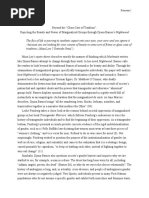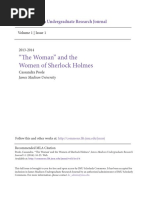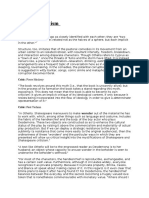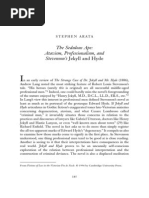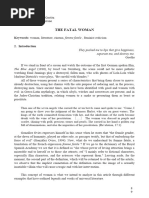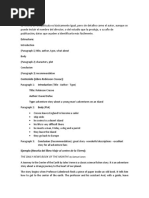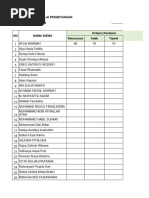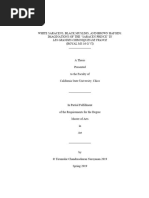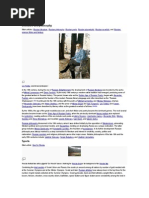York Notes Othello
York Notes Othello
Uploaded by
Henry JOhnsonCopyright:
Available Formats
York Notes Othello
York Notes Othello
Uploaded by
Henry JOhnsonOriginal Title
Copyright
Available Formats
Share this document
Did you find this document useful?
Is this content inappropriate?
Copyright:
Available Formats
York Notes Othello
York Notes Othello
Uploaded by
Henry JOhnsonCopyright:
Available Formats
LITA4: Notes
How are women presented in Othello, The Taming of the Shrew and the Miller’s Tale?
Othello
York Notes – P. 12
“Look at your house, your daughter, and your bags! / Thieves, Thieves” – imagery makes it clear that
women are seen as possessions to the male characters.
Brabantio believes Desdemona has subverted the natural order by eloping, decision to choose own
husband is “treason of the blood”.
Some critic see Des as a victim, others believe she is partly responsible for what happens to her.
Feminist readings of Des:
The gender politics of Othello
Feminist would consider the role of male and female characters in relation to the patriarchal
society context of the play.
Marilyn French explores the masculine value system at work in O. In spite of her
assertiveness in choosing her own husband, French suggests Desdemona ‘accepts her
culture’s dictum that she must be obedient to males’ and is ‘self-denying in the extreme’
when she dies.
Lisa Jardine shares above viewpoint about the misogyny of Othello. She suggests that the
stage world of Jacobean drama is wholly masculine and argues that there is only a male
viewpoint on offer.
Jardine asserts the view that Des proves to be ‘too-knowing, too-independent’ because of her
waywardness she is punished by patriarchy. She suggests Desdemona becomes a stereotype
of female passivity.
Marxist:
Dympna Callaghan considers the cultural significanceof Des wedding sheets and the
handkerchief, commenting on how these objects have economic and symbolic value in the
Renaissance.
Handkerchief – ‘miniture of the nuptial linens’ – crucially important to the stability of the
marriage of Othello and Desdemona.
New Historicist:
Othello context importance.
Violence against female characters, Leonard Tennenhouse – asserts the view that ‘Jacobean
tragedies offer up their scenes of excessive punishment as if mutilating the female could
somehow correct political corruption. The female in question may be completely innocent…
yet in play after play she demands her own death or else claims responsibility for her murder’.
He suggests that Des has to be destroyed because she is subversive.
Unlike many female critics he suggests that Des is the ‘embodiment of power’ when she
appears in Act 1 and defends her right to choose her own husband.
Orson Welles version portray Des as overly innocent.
Men and Women – York Notes: P64
LITA4: Notes
During the Renaissance many people believed that men were intellectually and morally
superior to women because of Christian teachings. John Knox, Protestnat clergymen wrote: ‘a
woman ought to serve her husband as unto God, affirming that in nothing has woman equal
power with man’.
You might also like
- Insight Pre-Intermediate SB 2013 166pDocument166 pagesInsight Pre-Intermediate SB 2013 166pMarcia Lo Bosco65% (23)
- Gender ADH and RossettiDocument3 pagesGender ADH and RossettiGurpreet Xx100% (3)
- York Notes - OthelloDocument2 pagesYork Notes - Othelloirishfellow12No ratings yet
- Shakespeare and Sax - OthelloDocument5 pagesShakespeare and Sax - Othellowaveywales12383% (6)
- AtrahasisDocument31 pagesAtrahasisGlenn Gatiba100% (2)
- Englisch AbiturDocument13 pagesEnglisch AbiturHenry JOhnsonNo ratings yet
- 2017 E Schreiben Nicht-Literarisch Erhoeht 2Document10 pages2017 E Schreiben Nicht-Literarisch Erhoeht 2Henry JOhnsonNo ratings yet
- Comedy of Manners - Final Paper OutlineDocument3 pagesComedy of Manners - Final Paper Outlinejamie marksNo ratings yet
- Literary Criticism: A Doll House, by Henrik IbsenDocument5 pagesLiterary Criticism: A Doll House, by Henrik IbsenArya LivpoolNo ratings yet
- ZAPOROJAN - GERMB425Paper - Final VersionDocument9 pagesZAPOROJAN - GERMB425Paper - Final VersionGeorge ZaporojanNo ratings yet
- Depictions of Gender, Mortality and Death in Webster's The Duchess of MalfiDocument8 pagesDepictions of Gender, Mortality and Death in Webster's The Duchess of MalfiKittie Amy0% (1)
- 22 Georgie Brown q33383 PP 227 232Document6 pages22 Georgie Brown q33383 PP 227 232Lahiruni SamarasekaraNo ratings yet
- Misogyny and Malhonnêteté: The Exposure of Hypocritical Beliefs of The Renaissance in The Plays of John WebsterDocument19 pagesMisogyny and Malhonnêteté: The Exposure of Hypocritical Beliefs of The Renaissance in The Plays of John Websterapi-310329662No ratings yet
- Swaminathan15 2Document22 pagesSwaminathan15 2rozhita88.sNo ratings yet
- CRITICISMDocument7 pagesCRITICISMMajoy ManzanillaNo ratings yet
- Othello CriticsDocument3 pagesOthello CriticsLê Thị Bách HợpNo ratings yet
- Beyond The Glass - Djuna Barnes NightwoodDocument5 pagesBeyond The Glass - Djuna Barnes NightwoodLaura CruzherNo ratings yet
- The Return of The Real: A Lancanian Reading of Poe's Dying Woman StoriesDocument12 pagesThe Return of The Real: A Lancanian Reading of Poe's Dying Woman StoriesHavajka Devojka100% (1)
- Happily Ever After? Marriage, Honor and Feminism in Two Novelas EjemplaresDocument12 pagesHappily Ever After? Marriage, Honor and Feminism in Two Novelas EjemplarespalinurodimessicoNo ratings yet
- Donohue, The Heart of Darkness Sexism and Racism in Classic LiteratureDocument8 pagesDonohue, The Heart of Darkness Sexism and Racism in Classic LiteratureBarbara WachalNo ratings yet
- Feminism and Ibsen's A Doll's HouseDocument7 pagesFeminism and Ibsen's A Doll's HouseSamy Ismail100% (1)
- Critical Perspectives On Shakespeare. Shakespearean Criticism Is An Effort To Force The Bard Into Categories, WhichDocument8 pagesCritical Perspectives On Shakespeare. Shakespearean Criticism Is An Effort To Force The Bard Into Categories, Whichjasjisha4No ratings yet
- Caesura 6.1 2019 Articol 2Document14 pagesCaesura 6.1 2019 Articol 2Asha PurnaNo ratings yet
- 2 Ijeloct20172Document10 pages2 Ijeloct20172TJPRC PublicationsNo ratings yet
- H.H. Richardsons Two Hanged Women. Our Own True Selves andDocument14 pagesH.H. Richardsons Two Hanged Women. Our Own True Selves andCarlos HenriqueNo ratings yet
- Cutting Edge: New Stories of Mystery and Crime by Women WritersFrom EverandCutting Edge: New Stories of Mystery and Crime by Women WritersRating: 3.5 out of 5 stars3.5/5 (32)
- The Concept of Feminism in Henrik Ibsen's A Doll's HouseDocument5 pagesThe Concept of Feminism in Henrik Ibsen's A Doll's HouseJoy Erica C. LeoNo ratings yet
- Women in Holmes WorkDocument9 pagesWomen in Holmes WorkShiela AringoNo ratings yet
- Othello Critics QuotesDocument5 pagesOthello Critics QuotesWally ThangNo ratings yet
- Othello As A Domestic Tragedy - Marriage and Moral ExtremismDocument8 pagesOthello As A Domestic Tragedy - Marriage and Moral ExtremismHussien MohmmedNo ratings yet
- The Sedulous Ape: Atavism, Professionalism, and Stevenson's Jekyll and HydeDocument26 pagesThe Sedulous Ape: Atavism, Professionalism, and Stevenson's Jekyll and HydeAlex ImmanuelNo ratings yet
- Bronte's Cleopatra - A Feminist Analysis of Catherine Earnshaw, Wild ChildDocument20 pagesBronte's Cleopatra - A Feminist Analysis of Catherine Earnshaw, Wild ChildNatalie Romero0% (1)
- The Representation of Women'smadness in A Doll's House and The Yellow Wallpapaer.Document9 pagesThe Representation of Women'smadness in A Doll's House and The Yellow Wallpapaer.chiara blardoni100% (1)
- Umair PaperDocument18 pagesUmair Paperasadrathor1989No ratings yet
- Fatal Women: Lesbian Sexuality and the Mark of AggressionFrom EverandFatal Women: Lesbian Sexuality and the Mark of AggressionRating: 3 out of 5 stars3/5 (1)
- Hubert Preface-L'Esprit Créateur, Volume 29, Number 3, Fall 1989Document8 pagesHubert Preface-L'Esprit Créateur, Volume 29, Number 3, Fall 1989Anonymous NtEzXrNo ratings yet
- Gender Oppression in The Enlightenment Era by Barbara CattunarDocument2 pagesGender Oppression in The Enlightenment Era by Barbara Cattunarlachimolala. kookieee97100% (1)
- Dark RomanticismDocument20 pagesDark RomanticismGilda MoNo ratings yet
- Amago2002 Article LesbianDesireAndRelatedMatters PDFDocument22 pagesAmago2002 Article LesbianDesireAndRelatedMatters PDFAnonymous yr4a85No ratings yet
- Reasserting Female Subjectivity in RichDocument11 pagesReasserting Female Subjectivity in Richpradip sharmaNo ratings yet
- A Doll's House6Document21 pagesA Doll's House6lavina marwahNo ratings yet
- English Essay: " Lolita or The Confession of A White Widowed Male"Document5 pagesEnglish Essay: " Lolita or The Confession of A White Widowed Male"Linda HayashiNo ratings yet
- The Fatal Woman PDFDocument11 pagesThe Fatal Woman PDFScribdTranslationsNo ratings yet
- Plot Structure of Joseph AndrewsDocument4 pagesPlot Structure of Joseph AndrewsMuhammad Jahan Zaib67% (3)
- Portfolio 1Document3 pagesPortfolio 1api-359171453No ratings yet
- Julius Rowan Raper - Narcissus From Rubble - Competing Models of Character in Contemporary British and American FictionDocument181 pagesJulius Rowan Raper - Narcissus From Rubble - Competing Models of Character in Contemporary British and American FictionCarlos DevotoNo ratings yet
- Othello - CriticsDocument6 pagesOthello - CriticsCarloNo ratings yet
- Realism in DramaDocument27 pagesRealism in DramaFatih KORKMAZNo ratings yet
- 3-IJESA Vol 3 - No 6-June 2024 - Paper2-Dr. Ibrahim1Document20 pages3-IJESA Vol 3 - No 6-June 2024 - Paper2-Dr. Ibrahim1المجلة الدولية للعلوم التربوية والآداب - EISSN: 2976-7237No ratings yet
- One Pager 1 - Lola BartlettDocument2 pagesOne Pager 1 - Lola BartlettLola BartlettNo ratings yet
- Frey-Sc-Scarlet Letter Final Draft and Reflective EssayDocument28 pagesFrey-Sc-Scarlet Letter Final Draft and Reflective Essayapi-242692028No ratings yet
- Paper 2 Model EssayDocument4 pagesPaper 2 Model EssayJunghoon KimNo ratings yet
- Alien Sex: 19 Tales by the Masters of Science Fiction and Dark FantasyFrom EverandAlien Sex: 19 Tales by the Masters of Science Fiction and Dark FantasyRating: 3.5 out of 5 stars3.5/5 (79)
- Othello As A Domestic Tragedy - Marriage and Moral ExtremismDocument8 pagesOthello As A Domestic Tragedy - Marriage and Moral ExtremismMuhammad Ammad ul Fahad IqbalNo ratings yet
- APznzab5vfLl1iStl0ol98rBD9lkzO1KN4sLR5DMEI AZQ5R0dw7X CYm IPcoM RoWNf5r1v40F 21uurMNZrAwq5b84q3gYlc1k29ySnp9Ke 1jXi27aWltBrovDsjGZdpulEz1hx Eal0E a6O0kSAurYitTAFHLg D6dJhcArUv1PHL2ldTrAnjTJ58f8X72GTDls MDTbPqldD7UODocument13 pagesAPznzab5vfLl1iStl0ol98rBD9lkzO1KN4sLR5DMEI AZQ5R0dw7X CYm IPcoM RoWNf5r1v40F 21uurMNZrAwq5b84q3gYlc1k29ySnp9Ke 1jXi27aWltBrovDsjGZdpulEz1hx Eal0E a6O0kSAurYitTAFHLg D6dJhcArUv1PHL2ldTrAnjTJ58f8X72GTDls MDTbPqldD7UOnancyver283No ratings yet
- The Beast Within: A Look at The Representation of Animals in Victorian LiteratureDocument10 pagesThe Beast Within: A Look at The Representation of Animals in Victorian LiteratureCarolina Estela Fragoso ColónNo ratings yet
- 588 1866 1 SM PDFDocument10 pages588 1866 1 SM PDFSuraj BrahmaNo ratings yet
- ANALYSIS Ellison, Ralph Invisible Man (1952)Document23 pagesANALYSIS Ellison, Ralph Invisible Man (1952)abekhti2008No ratings yet
- Intrigues in D DuchessDocument4 pagesIntrigues in D DuchessBishal GhoshNo ratings yet
- Lorraine OGrady Olympias Maid Reclaiming Black Female SubjectivityDocument23 pagesLorraine OGrady Olympias Maid Reclaiming Black Female Subjectivitymineramos100% (1)
- George Orwell and The Problem of Authentic ExistenceDocument4 pagesGeorge Orwell and The Problem of Authentic ExistenceMaria Magdalena MądryNo ratings yet
- A230B - X8 DoneDocument4 pagesA230B - X8 DoneSafeer IqbalNo ratings yet
- The Portrayal of Women in The Iliad - S. FarronDocument18 pagesThe Portrayal of Women in The Iliad - S. Farronalba.sanchez.varelaNo ratings yet
- A - Comparative - Analysis - of - The - Portraits of Tess Hardy Polanski Nature Landscape MythDocument7 pagesA - Comparative - Analysis - of - The - Portraits of Tess Hardy Polanski Nature Landscape MythJason SnapeNo ratings yet
- Good Rules and Bad Rules New Cutting Edge Intermediate Unit 11 Modals of Obligation and ProhibitionDocument1 pageGood Rules and Bad Rules New Cutting Edge Intermediate Unit 11 Modals of Obligation and ProhibitionHenry JOhnsonNo ratings yet
- Mystery Stories: Narrative TensesDocument4 pagesMystery Stories: Narrative TensesHenry JOhnsonNo ratings yet
- Dentist Tour Guide Politician: (Cleans The Streets)Document1 pageDentist Tour Guide Politician: (Cleans The Streets)Henry JOhnsonNo ratings yet
- 2018 E Schreiben Nicht-Literarisch ErhöhtDocument10 pages2018 E Schreiben Nicht-Literarisch ErhöhtHenry JOhnsonNo ratings yet
- The Expedition Narrative Tenses - 1020Document2 pagesThe Expedition Narrative Tenses - 1020Henry JOhnson100% (1)
- Who or Whose Grammar Drills Picture Description Exercises - 83844Document1 pageWho or Whose Grammar Drills Picture Description Exercises - 83844Henry JOhnsonNo ratings yet
- Intro To Dystopia and 1984Document26 pagesIntro To Dystopia and 1984Henry JOhnsonNo ratings yet
- Kcgo Englisch - De.enDocument47 pagesKcgo Englisch - De.enHenry JOhnsonNo ratings yet
- HANDMAIDS TALE Study NotesDocument22 pagesHANDMAIDS TALE Study NotesHenry JOhnson100% (2)
- Simpsons Family Tree Fun Activities Games 47108Document1 pageSimpsons Family Tree Fun Activities Games 47108Henry JOhnsonNo ratings yet
- A Family Tree Fun Activities Games Tests - 26433Document1 pageA Family Tree Fun Activities Games Tests - 26433Henry JOhnson50% (2)
- Generic Hybridization: The Short Story Blends With The Narrative Essay in George Orwell's Masterpiece Shooting An ElephantDocument7 pagesGeneric Hybridization: The Short Story Blends With The Narrative Essay in George Orwell's Masterpiece Shooting An ElephantFlorNo ratings yet
- Popular Scholars & Books On Jaimini SystemDocument2 pagesPopular Scholars & Books On Jaimini Systemvinothavel6059No ratings yet
- VN LLF Part IDocument24 pagesVN LLF Part Ison-do-6023No ratings yet
- Lafcadio Hearn SpeechDocument10 pagesLafcadio Hearn SpeechBisliya Jessy BinuNo ratings yet
- Book ReviewDocument2 pagesBook ReviewAbviany DueñasNo ratings yet
- Rekapitulasi Nilai Tahsin Xi Ipa 3 SMT 2 - 064503Document26 pagesRekapitulasi Nilai Tahsin Xi Ipa 3 SMT 2 - 064503Andri's Senaung TubeNo ratings yet
- NasreddinDocument2 pagesNasreddinnafinaa82No ratings yet
- From The Depths of Despair To The Promise of PresenceDocument296 pagesFrom The Depths of Despair To The Promise of PresenceCarlos Fasanando MendietaNo ratings yet
- Quiz On BhagavadGitaDocument42 pagesQuiz On BhagavadGitaPrashant JaniNo ratings yet
- The Best Mystery WritersDocument1 pageThe Best Mystery WritersD GomezNo ratings yet
- 21 Century Literature From The Philippines and The WorldDocument7 pages21 Century Literature From The Philippines and The WorldKEVIN RANSOM BAYRONNo ratings yet
- Bounce Toy Catalogue 2018Document28 pagesBounce Toy Catalogue 2018Mladen0% (1)
- On ReadingDocument11 pagesOn ReadingIlan MITMA CHAPANo ratings yet
- desoukDocument99 pagesdesoukSharjinaAhmedSraboniNo ratings yet
- Art 14Document12 pagesArt 14Hasan TariqNo ratings yet
- Debra Higgs SarasinsDocument97 pagesDebra Higgs Sarasinstoto grossoNo ratings yet
- Pandoras Box and Loo WitDocument14 pagesPandoras Box and Loo WitNikos PolyNo ratings yet
- A Trip To The MoonDocument14 pagesA Trip To The MoonMariusOdobașa100% (1)
- I Don't Want To Be Crazy ExcerptDocument19 pagesI Don't Want To Be Crazy ExcerptI Read YA100% (3)
- The Vulgar Question of Money Heiresses, Materialism, and The Novel of Manners From Jane Austen To Henry James by Michie, Elsie BrowningDocument320 pagesThe Vulgar Question of Money Heiresses, Materialism, and The Novel of Manners From Jane Austen To Henry James by Michie, Elsie BrowningEdna TricicNo ratings yet
- Jesus Christ in The Light of Holy Quran PDFDocument4 pagesJesus Christ in The Light of Holy Quran PDFMir Fateh Ali ShahNo ratings yet
- Dokumen - Pub - A Short History of The Italian Renaissance 1442600144 9781442600140 40 77Document38 pagesDokumen - Pub - A Short History of The Italian Renaissance 1442600144 9781442600140 40 77bellytone627No ratings yet
- UPSC Marathi Syllabus - IAS Mains Optional SubjectsDocument4 pagesUPSC Marathi Syllabus - IAS Mains Optional SubjectsNikhil JadhavNo ratings yet
- 1961, Plato's Republic, Rev.Document508 pages1961, Plato's Republic, Rev.Harrison100% (1)
- Module 1 Creative Writing vs. Other WritingDocument5 pagesModule 1 Creative Writing vs. Other WritingCharlieNo ratings yet
- Caution Thesis Writing in ProgressDocument4 pagesCaution Thesis Writing in Progresslesliethomascincinnati100% (2)
- Parallel Guide 33 The Johannine Letters: 1 John 2 John 3 JohnDocument9 pagesParallel Guide 33 The Johannine Letters: 1 John 2 John 3 JohnRoman CatholicNo ratings yet
- Russia: Literature and PhilosophyDocument5 pagesRussia: Literature and PhilosophyLinda SefaNo ratings yet
- Theme in Biblical NarrativesDocument374 pagesTheme in Biblical Narrativesmiqueias.levi0210No ratings yet
















